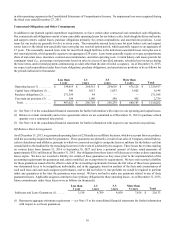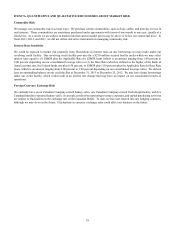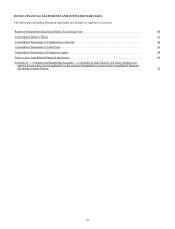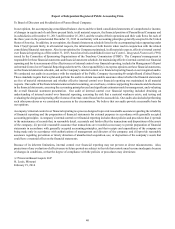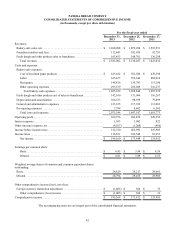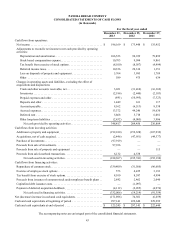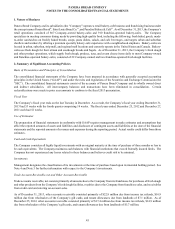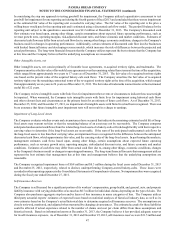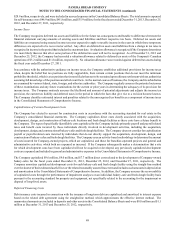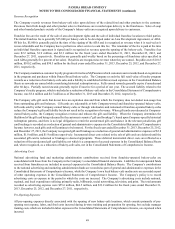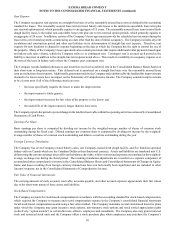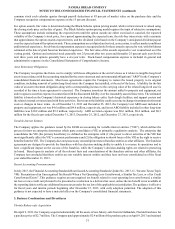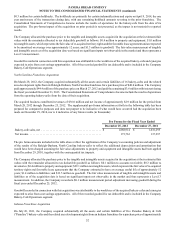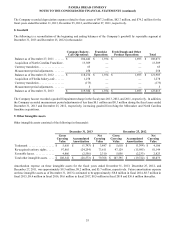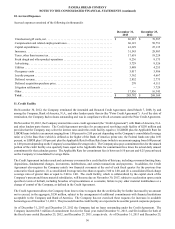Panera Bread 2013 Annual Report Download - page 54
Download and view the complete annual report
Please find page 54 of the 2013 Panera Bread annual report below. You can navigate through the pages in the report by either clicking on the pages listed below, or by using the keyword search tool below to find specific information within the annual report.PANERA BREAD COMPANY
NOTES TO THE CONSOLIDATED FINANCIAL STATEMENTS (continued)
46
The Company does not require collateral and maintains reserves for potential uncollectible accounts based on historical losses
and existing economic conditions, when relevant. The allowance for doubtful accounts at December 31, 2013 and December 25,
2012 was $0.1 million, respectively.
Inventories
Inventories, which consist of food products, paper goods, and supplies, are valued at the lower of cost or market, with cost
determined under the first-in, first-out method.
Property and Equipment, net
Property, equipment, leasehold improvements, and land are stated at cost less accumulated depreciation. Depreciation is provided
using the straight-line method over the estimated useful lives of the assets. Leasehold improvements are depreciated using the
straight-line method over the shorter of their estimated useful lives or the related reasonably assured lease term. Costs incurred
in connection with the development of internal-use software are capitalized in accordance with the accounting standard for internal-
use software, and are amortized over the expected useful life of the software. The estimated useful lives used for financial statement
purposes are:
Leasehold improvements . . . . . . . . . . . . . . . . . . . . . . . . . . . . . . . . . . . . . . . . . . . . . . . . . . . . . . . . . . . . . . . . . . . 15 - 20 years
Machinery and equipment . . . . . . . . . . . . . . . . . . . . . . . . . . . . . . . . . . . . . . . . . . . . . . . . . . . . . . . . . . . . . . . . . . 3 - 15 years
Furniture and fixtures . . . . . . . . . . . . . . . . . . . . . . . . . . . . . . . . . . . . . . . . . . . . . . . . . . . . . . . . . . . . . . . . . . . . . . 2-7years
Computer hardware and software . . . . . . . . . . . . . . . . . . . . . . . . . . . . . . . . . . . . . . . . . . . . . . . . . . . . . . . . . . . . 3-5years
Interest, to the extent it is incurred in connection with the construction of new locations or facilities, is capitalized. The capitalized
interest is recorded as part of the asset to which it relates and is amortized over the asset’s estimated useful life. No interest was
incurred for such purposes for the fiscal years ended December 31, 2013, December 25, 2012, and December 27, 2011.
Upon retirement or sale, the cost of assets disposed and their related accumulated depreciation are removed from the Company’s
accounts. Any resulting gain or loss is credited or charged to operations. Maintenance and repairs are charged to expense when
incurred, while certain improvements are capitalized. The total amounts expensed for maintenance and repairs was $56.6 million,
$48.0 million, and $39.5 million for the fiscal years ended December 31, 2013, December 25, 2012, and December 27, 2011,
respectively.
Goodwill
The Company evaluates goodwill for impairment on an annual basis during the fourth quarter, or more frequently if circumstances
indicate impairment might exist. Goodwill is evaluated for impairment through the comparison of the fair value of reporting units
to their carrying values. When evaluating goodwill for impairment, the Company may first perform an assessment of qualitative
factors to determine if the fair value of the reporting unit is more-likely-than-not greater than its carrying amount. This qualitative
assessment is referred to as a “step zero” approach. If, based on the review of the qualitative factors, the Company determines it
is not more-likely-than-not that the fair value of a reporting unit is less than its carrying value, the Company bypasses the required
two-step impairment test. If the Company does not perform a qualitative assessment or if the fair value of the reporting unit is
not more-likely- than-not greater than its carrying value, the Company performs the first step (“step one”) of the two-step impairment
test and calculates the estimated fair value of the reporting unit. If the carrying value of goodwill exceeds the estimated fair value,
there is an indication that impairment may exist and the second step must be performed to measure the amount of impairment
loss. The amount of impairment is determined by comparing the implied fair value of reporting unit goodwill to the carrying value
of the goodwill in the same manner as if the reporting unit was being acquired in a business combination. If the implied fair value
of goodwill is less than the recorded goodwill, the Company would record an impairment loss for the difference.
In considering the step zero approach to testing goodwill for impairment, the Company performs a qualitative analysis evaluating
factors including, but not limited to, macro-economic conditions, market and industry conditions, internal cost factors, competitive
environment, share price fluctuations, results of past impairment tests, and the operational stability and the overall financial
performance of the reporting units. During the fourth quarter of fiscal 2013, the Company utilized a qualitative assessment for
all but one of its reporting units where no significant change occurred and no potential impairment indicators existed since the
previous annual evaluation of goodwill, and concluded it is more-likely-than-not that the fair value was more than its carrying
value on a reporting unit basis.


